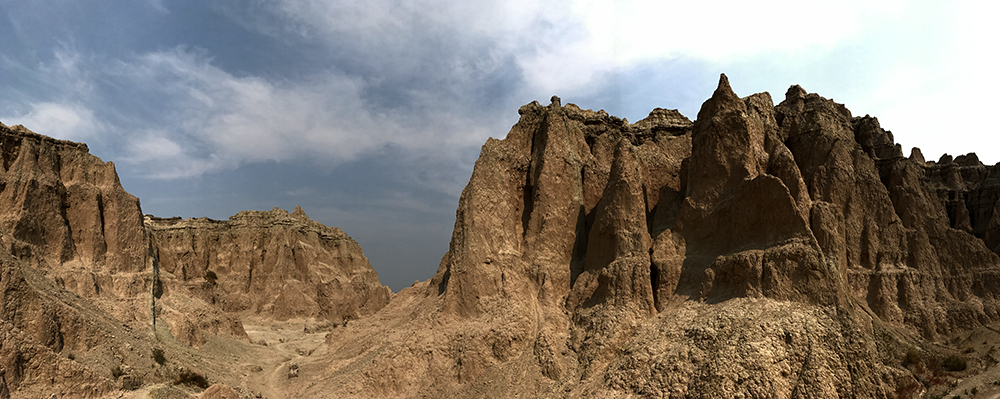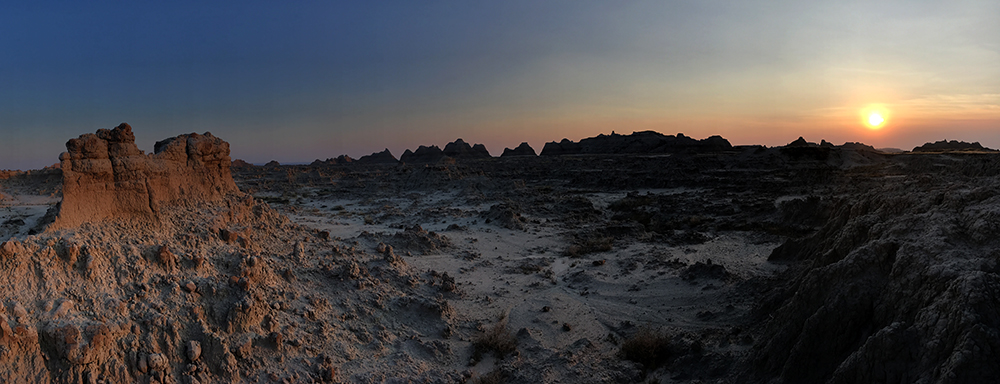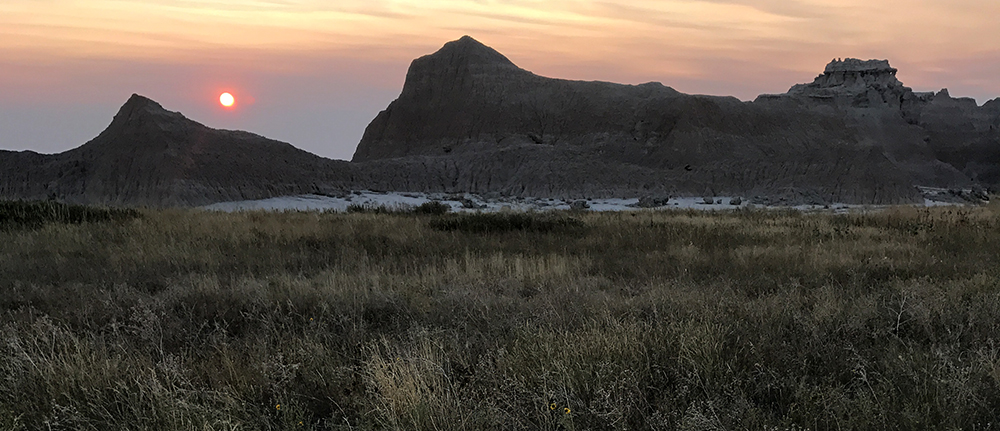Badlands National Park lies near the famed Black Hills region of southwestern South Dakota. The Lakota Sioux knew this area well, and referred to it as Mako Sica, or the “land bad”. This strange area is home to the largest protected prairie in the National Park System, as well as one of the richest fossil beds found on planet Earth.

Guide to Badlands
Badlands National Park
The Badlands is a prairie land, albeit one of the most scenic prairie lands you’ll likely ever see. This large swath of grasslands was divided long ago by the flow of the White River, which carved a valley, the north side of which took the shape of a wall.
This 60-mile-long wall is known as the Badlands Wall, and stretches from Kadoka, SD to Wall, SD. It forms the backbone of Badlands National Park.
To early inhabitants and travelers, the Badlands Wall appeared a daunting site. A lack of water, searing summer temperatures and the icy northern winds of bitter cold winters combined with the treacherous terrain surrounding the Wall led early folk to call this area the Badlands.

Today, the Badlands Wall and the White River separate two distinct prairie lands, an upper to the north, and a lower to the south. The park protects more than 244,000 acres and more than 250 species of mammal.
The park is home to a seemingly endless arrays of small, winding canyons, jagged ridges, green grasslands, abrupt bluffs, and towering spires. In addition to these beauties, an abundance of well-preserved fossils continues to be exposed, providing a link to the past Eocene and Oligocene epochs of some 30-40 million years ago.
Quietly, Badlands National Park today serves as a seemingly endless laboratory for paleontologists, scientists and naturalists who seek information about past eras. Erosive forces continue to unveil fossils of sabertooth tigers, camels, giant lizards, alligators and hornless rhinos of ages gone-by.
Where is Badlands National Park?
Badlands National Park is located in western South Dakota, due east of the Black Hills, and just south of Interstate 90. The park contains two units: the North Unit and the South Unit, also known as the Stronghold Unit. The North Unit is mostly surrounded by the Buffalo Gap National Grassland, while the South Unit is actually part of the Pine Ridge Indian Reservation, home to the Oglala Lakota Nation.
Many visitors will arrive from I-90. Those coming from the east exit 113 and enter the park through the Northeast Entrance, while those from the west take exit 110 and head straight south to the Pinnacles Entrance. A more scenic route can be enjoyed by exiting I90 in Rapid City and taking Highway 44 for 43 miles to the Interior Entrance, at the North Unit’s southeast corner.
For those coming from the Black Hills, Highway 40 eastbound will run along the western edge of the Stronghold Unit until it connects with the 2, which runs east to 27 where the Stronghold Unit’s White River Visitor Center is located.
Exploring Badlands
The Badlands beg exploration. The immediate visual stimulation upon entrance to the park alerts the adventurous visitor to the possibility that there may be something incredibly cool around that corner over there… So, the visitor just has to go find out.
This park offers few trails, and a limited array of activities for those who choose to color within the lines. But for those who don’t mind just heading into the maze, the Badlands turn out to be pretty… dare we say… Good…
North Unit
The North Unit welcomes the vast majority of visitors to Badlands. All of the park’s trails and most of its scenic overlooks, as well as the Badlands Loop Road are found here.
Badlands Loop Road
Most visitors to Badlands simply view the park from their cozy metal coffins on the 36-mile Badlands Loop Road. This road is one of the most scenic drives you’ll find and you won’t regret topping the tank off for this one. In fact, the construction of this route was stipulated in order for the park to obtain authorization back in 1929.
This paved route weaves through a collection of amazing colorful buttes, cliffs, canyons, spires and bizarre features that warp the senses. Along the road, motorists find more than a dozen scenic overlooks, a number of which offer picnic tables in order to facilitate an extended stop.
Be sure to keep an eye out for wildlife. This Bad landscape is home to bighorn sheep, bison and pronghorn, in addition to black footed ferrets and prairie dogs. Rattlesnakes and turtles make their homes here too, as do a number of smaller amphibians, such as frogs and toads.
While the Loop Road does indeed present a stunning landscape through the frame of the windshield, there is so much more to Badlands than can be appreciated from the ol’ Studebaker.
Sage Creek Rim Road
Another option for motorists and cyclists is the Sage Creek Rim Road, which runs along the northwestern boundary of the North Unit, connecting the Loop Road with Highway 44, just east of the town of Scenic. This 26-mile route is unpaved, but is usually passable by any capable vehicle, providing that a massive storm is not in progress.
The Sage Creek Rim Road departs the Badlands Loop Road to the west, just south of the Pinnacles Entrance. As it meanders along the rim above Sage Creek, it passes Roberts Prairie Dog Town, which provides a memorable stop. These guys are hilarious! Keep your distance though, as the park requires a 100-foot distance from all wildlife.
The Sage Creek Campground is located near the western park boundary. It is a primitive campground with 22 sites that have picnic tables. The campground has pit toilets, but there is no running water.
Badlands Fossil Prep Lab
Any visitor to Badlands National Park who does a bit of research into the park will find that this area holds one of the world’s most well-preserved fossil beds from the late Eocene and early Oligocene epochs. In laymen’s terms, this means that there are a lot of skeletal remains here from mammals that lived roughly 30 to 50 million years ago.
It is unlikely that the average park visitor will be able to go out and dig up remains themselves, as this requires a bit of red tape. Nevertheless, the park reports that hundreds of fossils are found each year by visitors, with 375 fossils reported in 2019 alone. In the name of scientific research, the park service asks that you leave these fossils as they are found and report their location to a park ranger.
In an effort to educate the public about the ongoing scientific research surrounding these ancient life forms, the park provides public access to the Badlands Fossil Preparation Lab. Located in the Ben Reifel Visitor Center, this lab houses paleontology exhibits and acts as a working laboratory in which the park’s fossil remains are preserved and studied.
The Fossil Prep Lab is typically open from the second week of June through the third week in September.
Stronghold Unit
The southern unit of the park is known as the Stronghold Unit, and is located entirely within the boundaries of the Pine Ridge Indian Reservation, which is owned by the Oglala Sioux Tribe. The land is managed by the National Park Service, under an agreement with the tribe.
Prior to its designation as a national monument in 1976, this land was used as a bombing range by the US Air Force from 1942 to 1968. Today, there are reportedly remains of unexploded ordinances throughout the landscape, so tread with caution.
The unit holds 133,000 acres, much of which is inaccessible without permission from individual land owners. The only “easily” accessible area is the Sheep Mountain Table, which is 7 miles one-way, and is rarely maintained. It is best to have a high-clearance 4×4 for this one.
Check in at the White River Visitor Center to inquire about heading out into the Stronghold Unit Backcountry. It is sure to provide a unique Badlands experience.
Palmer Creek
This area is absolutely removed from anything, and is unaccessible by vehicular means. It is part of the national park, but is basically land locked, surrounded by private lands. Accessing the Palmer Creek area requires advance permission from adjacent landowners whose land would be crossed en route to Palmer Creek.
Contact the White River Visitor Center for more information regarding the Palmer Creek area. (605) 455-2878
What to do in Badlands
Badlands offers few options for on-trail distance hiking, with the 5-mile one way Castle Trail being the longest developed trail in the park. There are numerous other options for those seeking quick hikes to viewpoints, but nothing that really takes one into a true wilderness.

Those seeking a true wilderness experience in Badlands will likely need to journey into the park’s backcountry and just see what the hell is really out there. Backcountry permits are currently not needed in this park, but it is recommended that adventurers stop by the Ben Reifel Visitor Center and score some beta from one of the park’s backcountry rangers before heading out.
A scenic drive with a couple of stops along the Badlands Loop Road, a long winding hike past amazing natural pyramids on the Castle Trail, or a short stroll from the car into the heart of the park’s strange formations will likely leave the casual visitor with a strange appreciation for a land that is indeed, “bad”….
Is the land really “Bad”?
The Lakota Sioux called it Maco Sica. Early Spanish explorers knew it as “tierra baldia“, or waste land, while the French fur trappers referred to it as “les mauvaises terres a traverser“. All of these phrases can be translated to infer that the land is essentially… bad.
Now, it may well be the case that if one were traveling across the plains on horseback, or laden with burdensome possessions, traveling in a large group of young and old, in a wagon train without modern conveniences such as air conditioned seats, this land may indeed seem “bad”…
Today, we understand that these well-meaning folks quite possibly meant “bad” in the same way that RUN DMC meant “bad” when they threw down the fresh lyrics “not bad meaning bad, but bad meaning good“.
Park Junkie Verdict
Badlands National Park holds a special place in my national park history. My mother often speaks of a trip she took to the Badlands when she was a young woman, touring with one of her girlfriends who happened to be a travel agent. Although she offers few details of that journey other than that it was “mighty pretty”, it is clear that she was intrigued by the bizarre landscape and speaks of it with fondness, proud to have been there.
For me, this was the first park I visited when I first headed into the Great American West back in 1997. I was stood immediately staggered by the coolest terrestrial formations my young, midwestern eyes had ever seen. Of course the Badlands were just a teaser of what was to come when I arrived in the true west, but they remain in my mind as one of the coolest early scenes from my first trip west.
My subsequent visits have provided a greater insight into the scientific importance of the Badlands, and to the wondrous backcountry scenery that exists in this park. A venture into through the park’s remote terrain can be a real treat that provides endless photographic opportunities. You’ll feel like a National Geographic photographer, at least until you emerge from your darkroom.
While a cursory glance at the map may leave a visitor with little excitement due to the lack of trails, there are off-trail countless routes through this rugged land that will instill a great awe for this “Bad” land.
See ya there…
Guide to Badlands
Relevant Links
National Park Guides

All content found on Park Junkie is meant solely for entertainment purposes and is the copyrighted property of Park Junkie Productions. Unauthorized reproduction is prohibited without the express written consent of Park Junkie Productions.
YOU CAN DIE. Activities pursued within National Park boundaries hold inherent dangers. You are solely responsible for your safety in the outdoors. Park Junkie accepts no responsibility for actions that result in inconveniences, injury or death.
This site is not affiliated with the National Park Service, or any particular park.
